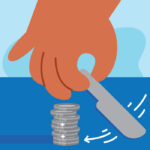
Investigate friction by knocking coins out of a stack. Try to keep the tower standing!
Grades: 1st grade and above
Time: 15 minutes
Materials: 12 nickels; 12 pennies; butter knife; table or other flat and smooth surface; adult supervision; 12 quarters or dimes (optional)
Steps:
- Stack 12 nickels in an even tower.
- Try to push or pull the nickel at the very bottom. What happens?
 Reset the stack of nickels. Now use the butter knife to hit the nickel at the bottom. How many nickels can you remove from the bottom of the stack before it falls over?
Reset the stack of nickels. Now use the butter knife to hit the nickel at the bottom. How many nickels can you remove from the bottom of the stack before it falls over?- Repeat steps 1 through 3 using pennies. Did you get the same results? What happened differently with the pennies compared to the nickels?
- Move a coin from the middle of the stack. What happens?
Why did the stack of coins stay in place? The tower of coins is at rest. According to Newton’s First Law of Motion, an object at rest will stay at rest. So the only way the coins will move is if an outside force (like your hand) acts on the coin (like pushing or pulling).
When you use the butter knife to hit the bottom nickel, it moves. Perhaps when you tried to use your hand to move the bottom coin, the stack fell. Why? Because when two objects – like two coins in the stack – rub against each other, they create friction.
When one object moves, friction causes the other to move with it, almost like they are stuck together. That’s why if you move a coin with your hand, the other coins in the stack get dragged along with the moving coin and the tower falls. But if the bottom coin is moved quickly, the friction does not have time to move the stack. So when you hit the bottom coin with a knife, it moves fast enough for the stack to stay together!
